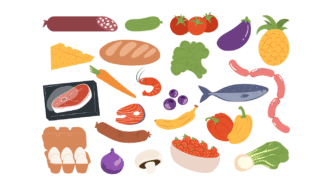LESSON OVERVIEW
This lesson plan focuses on the pronunciation of foreign food names. We want to show students how such names are pronounced in American and British English as well as have a bit of fun. We think that all foodies will love this worksheet ?
B2 / Upper Intermediate45 minStandard LessonPremium Plan
FOREIGN FOOD NAMES
The worksheet starts with a short discussion about pronouncing words that come from different languages, especially the names of dishes. Next, to students watch a short funny video which will introduce them into the topic of the lesson. Before the main pronunciation task, we first show students what phonetic transcription is by making them guess one sentence written in phonetic script. Next, students have a box with foreign food names (such as paella, croissant, borscht, tagine, etc.) and they have to match them with the correct phonetic scripts. To practice pronouncing these names, you can model the pronunciation yourself or you may play these words using the links we provide (source: YouGlish and Forvo) and ask your students to repeat the whole list afterwards.
GUESSING GAME
Students have to match the definitions to the correct dishes from the previous exercise and have a short discussion about them. After that, students move to a guessing game. They choose one card and describe the dish to their partner. When their partner guesses the dish, they need to pronounce it together correctly and check it with the teacher. Of course, if students don’t know some of the dishes on the cards, they should skip the card and get another one. As an extension, you can finish the lesson with repeating all these foreign food names together.
WORKSHEETS
Subscribe to unlock these and many other Standalone lesson with the Premium plan
Subscribe












It’s very useful! Thanks very much
My student benefitted a lot from this lesson! He wasn’t familiar with phonetic script before our class, but he learned to identify syllable markers, length symbols, and vowel symbols in phonetic transcription through intuition, thanks to how the lesson is laid out. It should be helpful the next time he consults a dictionary. Thanks for another great class Justa!
Hi! Thanks for taking the time to comment! I’m glad the lesson came in handy 🙂
/kɹəˈsɑnt/UK:/ˈk(ɹ)wæsɒ/̃
What is the upside-down /r/ symbol??
Not familiar with it in the phonemic chart.
and isn’t the /æ/ sound cAt?
I don’t hear that sound
Hi! You can read more about the upside-down /r/ symbol here. It’s used in French, hence here in the word ‘croissant’.